Hashweh (Arabic Ground Beef and Rice)
Apr 22, 2024, Updated Jun 17, 2024
This post may contain affiliate links.
If you’re a fan of delicious one-pot meals, this recipe is made for you! Hashweh is a Middle Eastern rice dish made with ground beef and rice perfectly seasoned with warm spices.
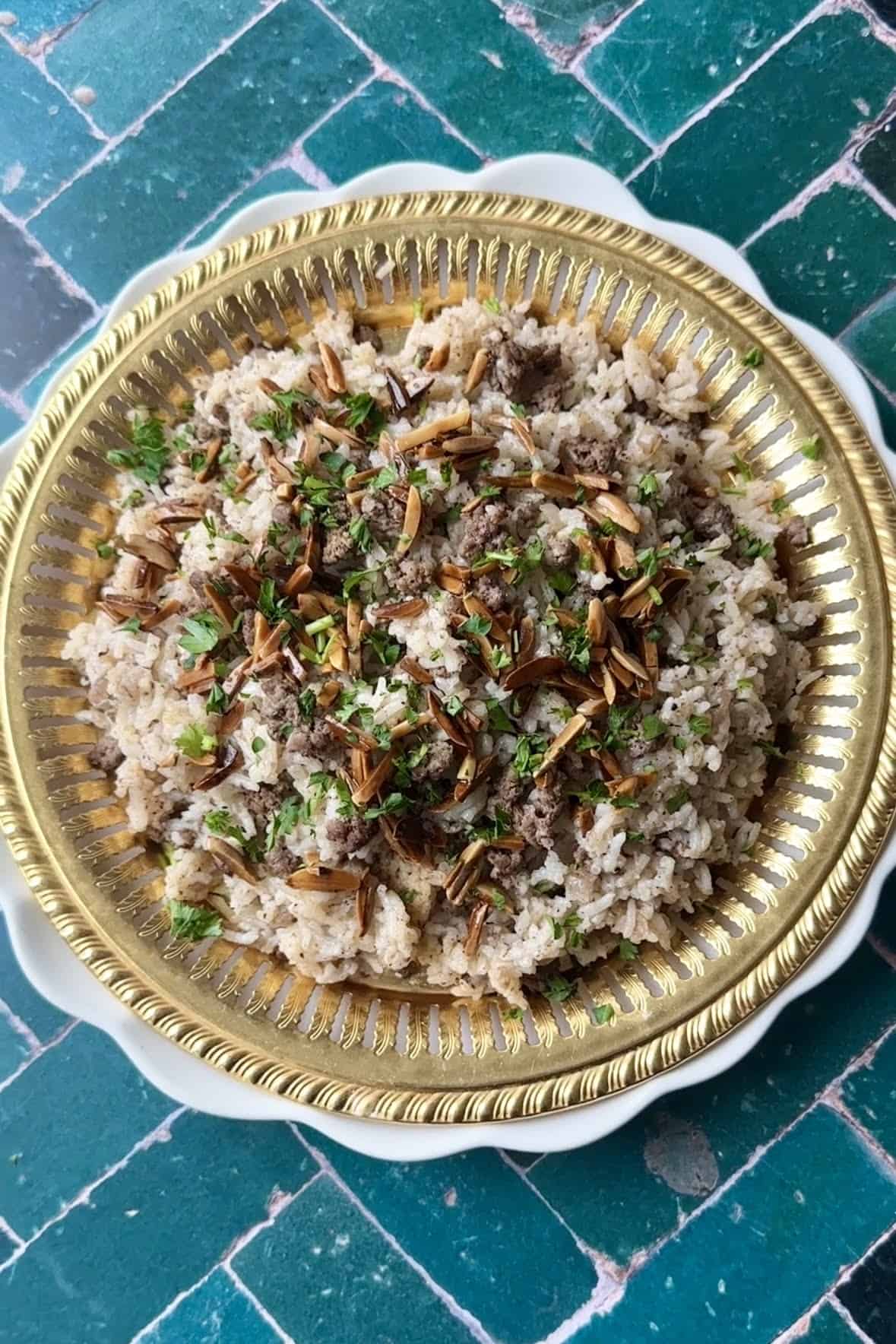
When it comes to Middle Eastern dishes, the rice-based ones truly stand out! From the fragrant Basmati rice adorned with herbs in sabzi polo to the hearty maqluba and mujadara, each dish tells a story of tradition and culture. My hashweh rice recipe is another unique and delicious Middle Eastern recipe that I cannot wait to share with you today. Whether you serve it as a meal or a side, hashweh is guaranteed to impress with its hearty ingredients and robust flavors.
Table of Contents
- Recipe Highlights
- What Is Hashweh?
- History of Hashweh
- Why You Will Love Hashweh?
- Key Ingredients
- How to Make Hashweh
- What to Serve with Hashweh
- Tips To Make The Best Lebanese Hashweh
- Variations and Substitutions
- Storage
- Frequently Asked Questions
- Other Middle Eastern Recipes You Must Try
- Hashweh Recipe (Arabic Ground Beef and Rice)
Recipe Highlights
Cultural Influence: Levantine
Preparation Technique: Sautéing
Dietary Info: Balanced, can be adapted to suit different dietary preferences
Signature Taste: Fragrant
Skill Level Required: Beginner-friendly
What Is Hashweh?
Hashweh is a traditional Middle Eastern dish made with seasoned ground beef, rice, and aromatic spices. The word “hashweh” in Arabic means “stuffing”, reflecting its origin as a flavorful filling used in stuffed vegetables and other dishes.
The dish typically consists of sautéed onions and ground beef seasoned with spices like cinnamon, allspice, and 7 spices, mixed with rice, and cooked together until tender. Just like my kibbeh recipe, this one is also packed with a lot of flavor.
Hashweh rice is known for its rich flavor, hearty texture, and comforting aroma, making it a popular choice in Middle Eastern cuisine.
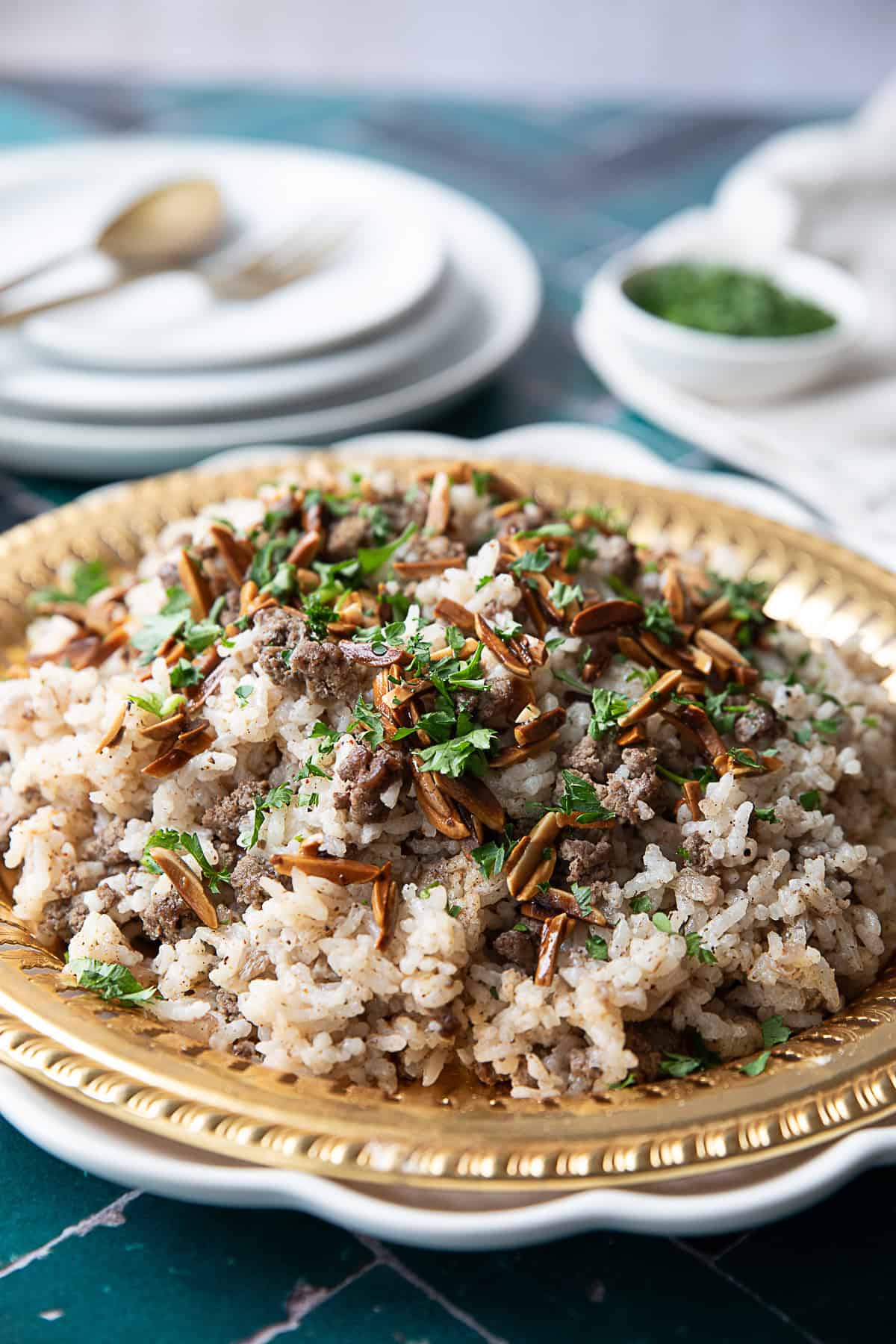
History of Hashweh
The history of hashweh can be traced back to traditional Middle Eastern cuisine, particularly in the Levant region (including countries like Lebanon, Syria, Palestine, and Jordan), where stuffed dishes are prevalent.
Hashweh, which means “stuffing” in Arabic, was traditionally used as a flavorful filling for various dishes, including stuffed vegetables like eggplant, zucchini, and bell peppers. Over time, this stuffing evolved into a standalone dish by combining seasoned ground meat with rice and aromatic spices.
The dish likely emerged as a way to make use of available ingredients, particularly rice and ground meat, which are staples in Middle Eastern cuisine.
Hashweh rice has become a beloved dish in Middle Eastern households, often prepared for family gatherings, celebrations, and special occasions. Its hearty and comforting nature has made it popular, making it a staple dish in every house.
Why You Will Love Hashweh?
Versatile: You can serve hashweh as a main dish or a side. It’s suitable for various meals and occasions.
Rich flavor profile: The combination of ground meat, onions, and aromatic spices creates a flavorful and satisfying dish.
Customizable: It can easily be adaptable to personal taste preferences by adjusting spices, herbs, and additional ingredients.
Easy to make: With simple ingredients and straightforward steps, Hashweh rice is convenient to prepare.
Family favorite: Loved by both adults and children, Hashweh rice is a crowd-pleaser for family dinners.

Key Ingredients
Olive oil: Choose a good-quality extra virgin olive oil for its flavor and health benefits. It adds richness to the dish and enhances the overall taste.
Ground beef: Opt for lean ground beef for a healthier option. Alternatively, you can use ground lamb or a combination of both for added flavor.
Onion: Yellow or white onions work well in this recipe. They add sweetness and depth of flavor to the dish when sautéed.
Jasmine rice: Jasmine rice complements the flavors of the dish beautifully.
Seven spice: Also known as Lebanese seven spice blend, it typically includes a mix of spices such as cumin, coriander, cloves, nutmeg, and cinnamon. You can find pre-made blends in Middle Eastern grocery stores or make your own by following my seven spice blend recipe.
Cinnamon: Use ground cinnamon for its warm, sweet flavor that pairs perfectly with the savory spices and meat in the dish.
Allspice: Ground allspice adds a unique, complex flavor to your dish.
Salt: Add salt to taste.
Water: The water-to-rice ratio is crucial for achieving the perfect texture, so measure accurately.
Garnish: Toasted pine nuts or slivered almonds add a crunchy texture and nutty flavor to the dish, while chopped parsley provides freshness and color contrast.
How to Make Hashweh
Step 1: Sauté the Onion
Heat 2 tablespoons of olive oil in a large pan over medium-high heat. Add the finely chopped onion to the pan. Sauté the onion for about 5 minutes until it becomes soft and translucent, stirring occasionally to prevent burning.

Step 2: Brown the Ground Beef
Once the onion is soft, add 1 pound of ground beef to the pan. Break up the ground beef with a spoon and cook until it’s browned and no longer pink, stirring occasionally to ensure even cooking.

Step 3: Add the Spices and Rice
Sprinkle 1 teaspoon of the seven spice blend, 1/2 teaspoon of cinnamon, 1/2 teaspoon of allspice, and 1 teaspoon of salt over the browned beef and onion mixture.

Stir well to combine, then add 11/2 cups of jasmine rice to the pan, stirring it into the beef and onion mixture until evenly distributed.

Step 4: Simmer
Pour 2 cups of water into the pan, ensuring that the rice is fully submerged.

Let the rice mixture cook covered for 30 minutes on medium-low heat. Once simmering, reduce the heat to medium-low and cover the pan.

After cooking, remove the pan from the heat and let it sit, covered, for an additional 10 minutes.

Step 5: Garnish and Serve
Just before serving, sprinkle toasted pine nuts or slivered almonds and chopped parsley over the top of the rice. This adds a delightful crunch and fresh flavor to the dish.
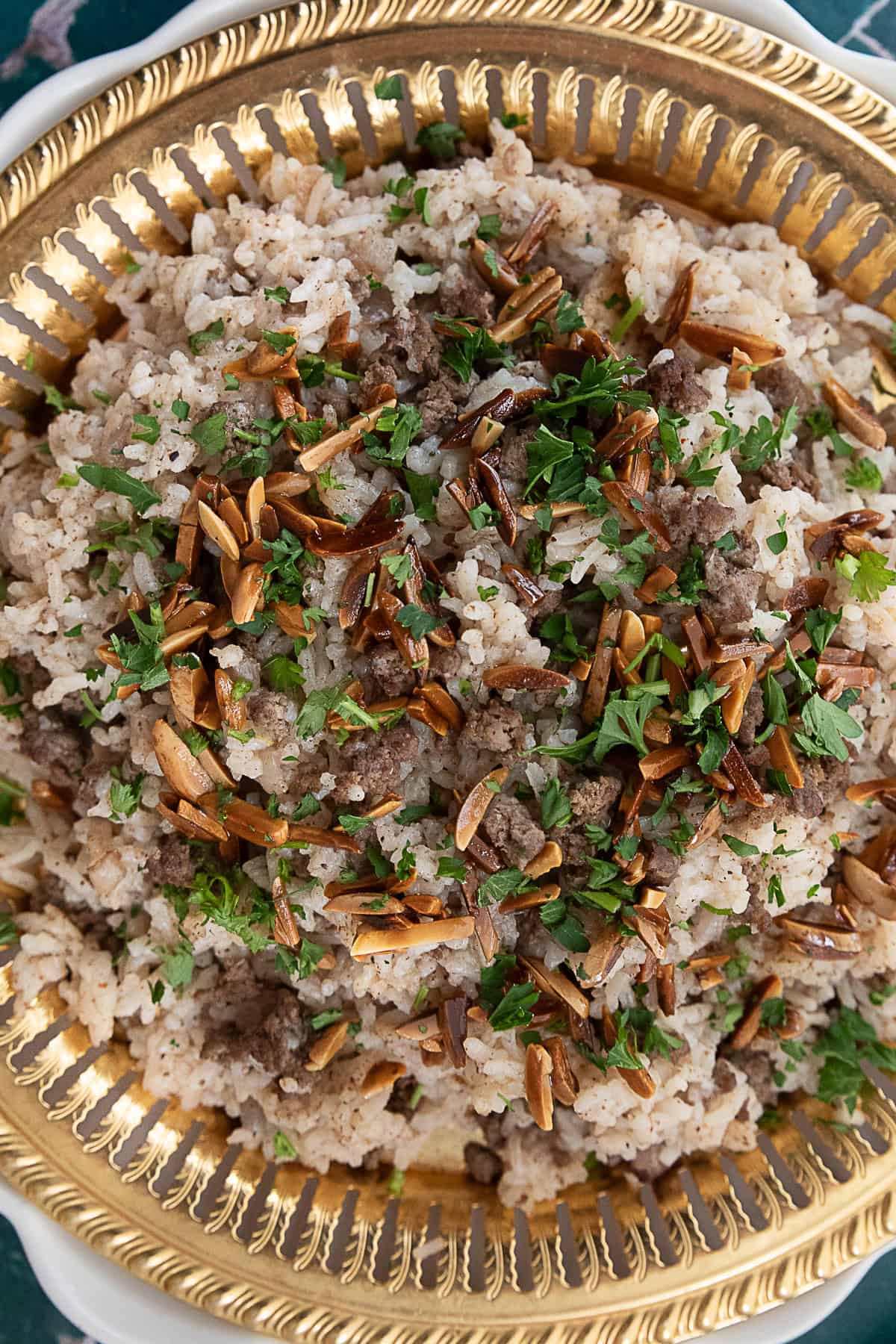
What to Serve with Hashweh
Wondering what to serve with Hashweh? Here are some delicious options:
- Middle Eastern Tahini Salad
- Tabouli Salad Recipe (Tabbouleh)
- Fattoush Salad Recipe
- No-Yeast Flatbread
- Homemade Hummus Recipe
Tips To Make The Best Lebanese Hashweh
Choose the Right Rice: Choose medium or long-grain rice, such as jasmine or basmati, for the best texture and flavor. These varieties absorb flavors well and result in fluffy, separate grains.
Sauté the Onions: Take your time to sauté the onions until they’re soft and translucent. This helps to develop their sweetness and adds depth of flavor to the dish.
Season Generously: Don’t skimp on the spices! Hashweh rice relies on a flavorful blend of spices like cinnamon, allspice, and seven spice blend. Season the meat mixture generously to ensure a rich and aromatic dish.
Toast the Nuts: If using nuts for garnish, toast them lightly before sprinkling them over the rice. They add a delicious crunch to the dish.
Let it Rest: After cooking, let the Hashweh rice sit, covered, for about 10 minutes off the heat. This allows the flavors to meld and the rice to finish steaming, resulting in a perfectly tender and fluffy texture.
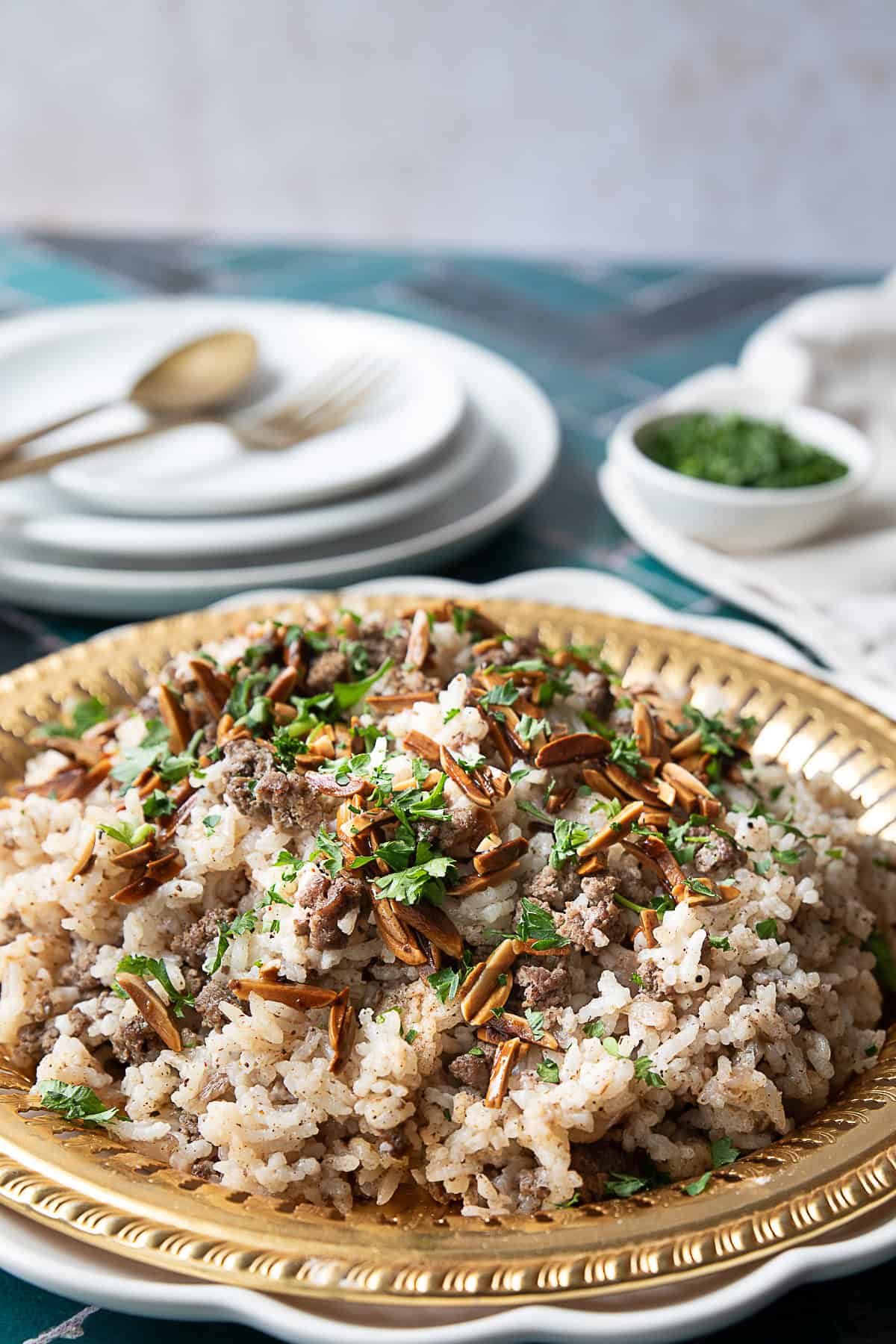
Variations and Substitutions
Additional vegetables: Create a vegetable-packed version by adding diced carrots, zucchini, eggplant, or mushrooms to the meat mixture.
Rice Substitutions: Swap jasmine rice with basmati, long-grain white rice, or even brown rice for a healthier alternative. Keep in mind that cooking time would vary depending on the rice.
Storage
Refrigeration: Allow hashweh to cool completely before transferring it to an airtight container. Store hashweh in the refrigerator for up to 3-4 days.
Freezing: If you want to store hashweh for a longer period, you can freeze it. It can be frozen for up to 3 months. Thaw it in the fridge overnight before reheating.
Reheating: Reheat hashweh in a skillet or microwave until heated through, adding a splash of water or broth if it seems dry.
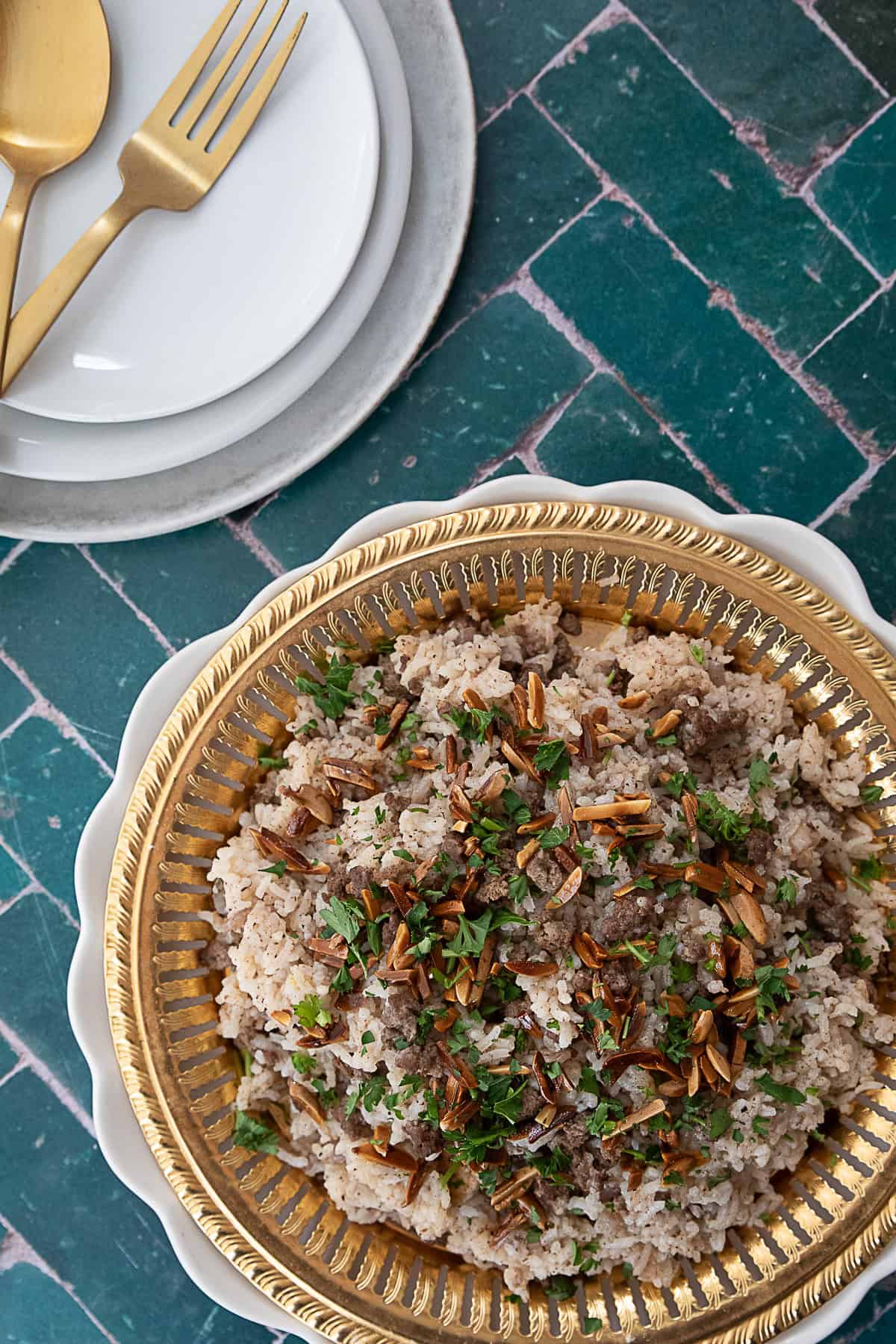
Frequently Asked Questions
Yes, hashweh is naturally gluten-free since it’s made with rice and ground meat, which do not contain gluten. However, if you’re following a gluten-free diet, it’s essential to ensure that the spices and other ingredients used are also gluten-free to avoid cross-contamination.
Yes, hashweh can be made ahead of time and stored in the refrigerator for 3-4 days. It can also be frozen for up to 3 months. Thaw it in the fridge overnight before reheating.
Long-grain rice, such as jasmine or basmati, is typically used for hashweh. These varieties have a light, fluffy texture and absorb flavors well, enhancing the dish’s overall taste.
If your rice grains are still hard, it indicates there wasn’t enough moisture or a lot of steam escaped during cooking. Simply spray the rice with about ½ cup of water, cover it, and let it steam for an additional 10 minutes on low heat. Check back, and you should find it much improved.
Hashweh can be served as either a main dish or a side dish, depending on the occasion and how it’s prepared. It’s hearty and flavorful enough to stand alone as a main course, but it also complements other Middle Eastern dishes as a side.
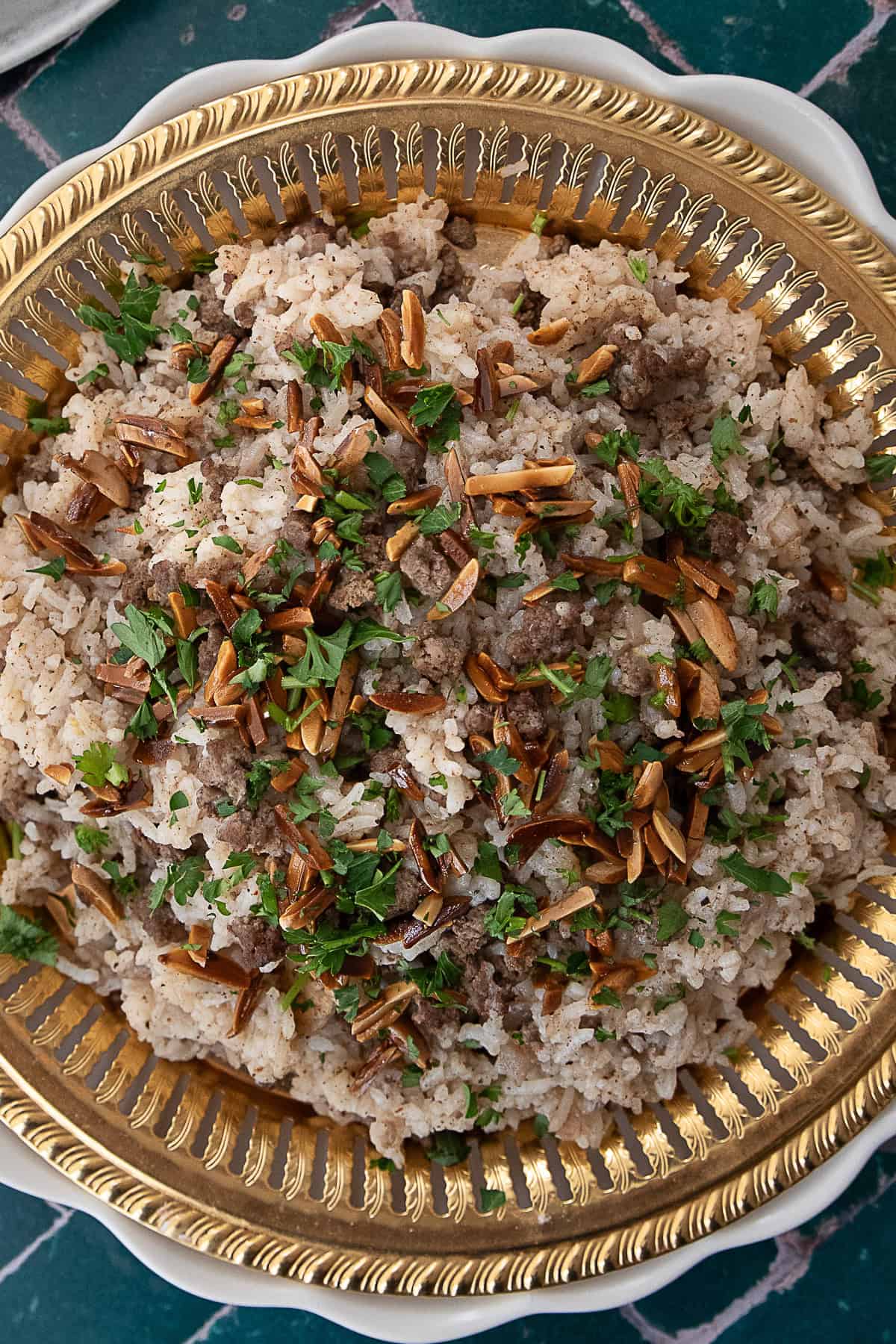
Other Middle Eastern Recipes You Must Try
Middle Eastern Recipes
Molokhia Recipe
Middle Eastern Recipes
Musakhan (Palestinian Sumac Chicken and Onion)
Beef and Lamb
Lamb Shawarma
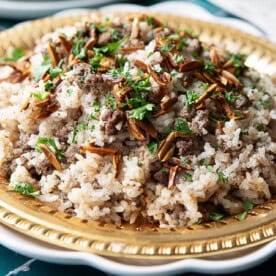
Hashweh Recipe (Arabic Ground Beef and Rice)
Ingredients
- 2 tablespoons Olive oil
- 1 Onion, chopped
- 1 pound Ground beef
- 1 teaspoon Seven spice
- ¼ teaspoon Cinnamon
- ¼ teaspoon Allspice
- 1 teaspoon salt
- 1½ cups Jasmine rice
- 2½ cups Water
Garnish
- 1 tbsp olive oil
- 2 tbsp slivered almonds
- 1/4 cup parsley , chopped
Instructions
- Heat 2 tablespoons of olive oil in a large pan over medium-high heat. Add the finely chopped onion to the pan. Sauté the onion for about 5 minutes until it becomes soft and translucent, stirring occasionally to prevent burning.
- Once the onion is soft, add 1 pound of ground beef to the pan. Break up the ground beef with a spoon and cook until it's browned and no longer pink, stirring occasionally to ensure even cooking.
- Sprinkle 1 teaspoon of seven spice blend, ½ teaspoon of cinnamon, ½ teaspoon of allspice, and 1 teaspoon of salt over the browned beef and onion mixture.
- Stir well to combine, then add 1½ cups of jasmine rice to the pan, stirring it into the beef and onion mixture until evenly distributed.
- Pour 2 cups of water into the pan, ensuring that the rice is fully submerged. Once simmering, reduce the heat to medium-low and cover the pan.
- Let the rice mixture cook covered for 30 minutes on medium-low heat.
- After cooking, remove the pan from the heat and let it sit, covered, for an additional 10 minutes.
- To make the garnish, heat the olive oil in a small pan and toast the slivered almonds for a few minutes until they're golden brown.
- Just before serving, sprinkle toasted slivered almonds and chopped parsley over the top of the rice.
Video
Notes
Nutrition
Nutrition information is automatically calculated, so should only be used as an approximation.
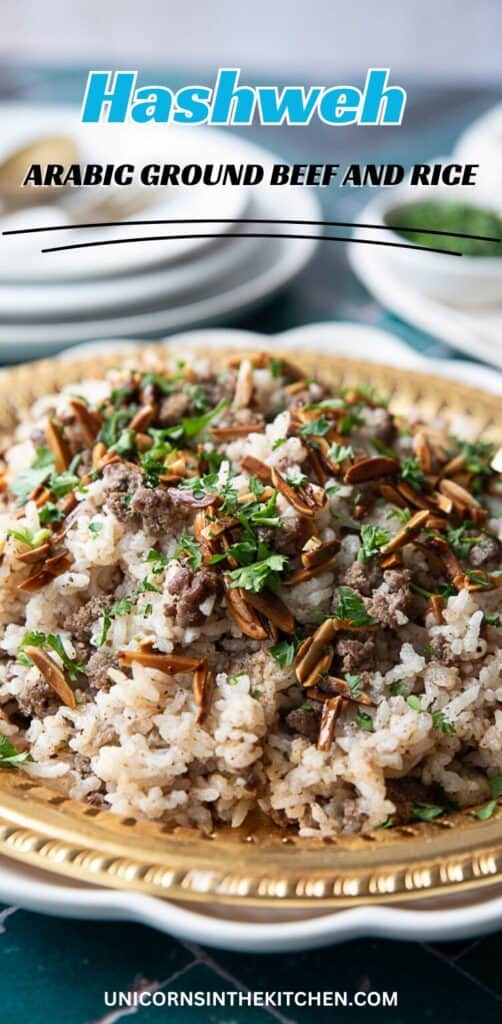
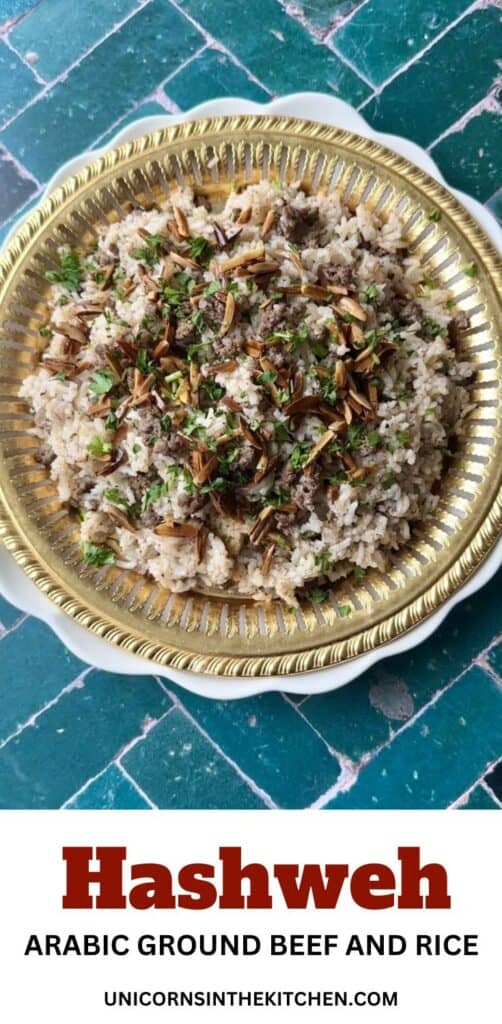



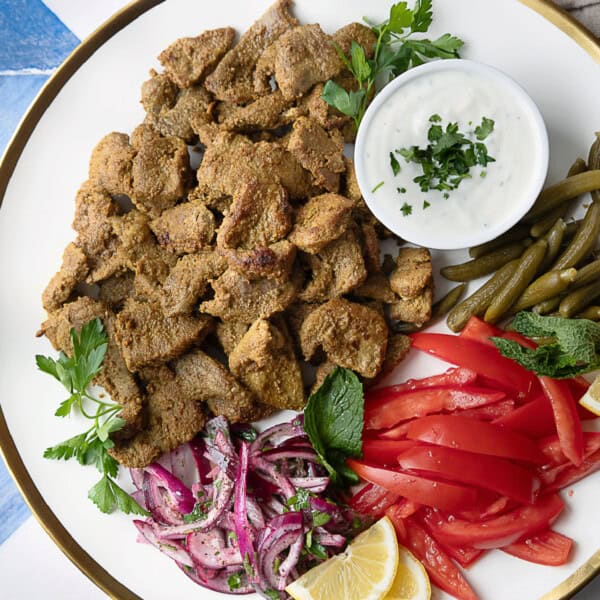









We love Middle Eastern Food and this dinner does not disappoint, the flavor is out of this world! Everyone loved it and I will be making it again, thank you so much!
Loved the cinnamon in this. Really good!
This was really delicious! Super easy to make, too
I’m always looking for new ground beef recipes to try and this one looks incredible! Can’t wait to make it for dinner soon!
What an incredible recipe! I always love trying new flavors from around the world and this was such a delicious meal.
This was such a unique and unexpected recipe that does not disappoint! Easy, hearty and delicious; definitely, a new favorite recipe!